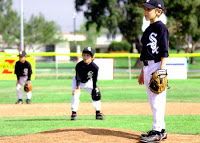Unaccounted Workload Factor: Game-Day Pitch Counts in High School Baseball Pitchers – An Observational Study
Zaremski JL, Zeppieri G, Jones DL, Tripp BL, Bruner M, Vincent HK, Horodyski M. Orthop J Sports Med. 2018; 6(4):2325967118765255
Take-Home Message
Pitch counts for baseball pitchers typically only include those completed as part of regulation play. Warm-up and bullpen pitches should be considered in total pitch counts to better capture actual workload during a game.
Summary
Sports medicine researchers have established that injuries to the upper extremity as a result of repetitive throwing are frequent in high school baseball pitchers. Risk factors, such as high pitch counts and poor pitching mechanics, have been identified and baseball regulating bodies have enacted recommendations and policy to aid in protecting pitchers from injury. However, the prevalence of injuries has not declined; therefore, warm-up and bullpen activity may present repetitions that increase total pitch count but to date have not been considered. The authors hypothesized that current pitch counts (regulation pitches) are underrepresented by up to 30-40% and many pitches likely occur during warm-up and bullpen activity. Additionally, the authors postulate there would be highly variable pitch counts during bullpen activities. For this observational study, researchers collected counts for all pitches thrown from a mound for 34 high schools over the course of one competitive season (February to May). Pitches from a mound included those completed while in the bullpen during warm-up, between innings, and during innings. A total of 13,769 pitches were tallied over the collection period for 115 varsity starting pitcher outings. During this time, no pitcher violated Major League Baseball’s (MLB) age-recommended game pitch count of 105 pitches. Bullpen and warm-up activity increased the average pitch count to 119.7 pitches per game compared to 68.9 during regulation play. Furthermore, compared to pitch counts during regulation play, bullpen and warm-up activity increased the total pitch volume by 42% thereby causing approximately 70% of the 115 outings over the 105-pitch count threshold deemed appropriate by the MLB. As hypothesized, bullpen activity was variable among pitchers with a range of 11 pitches. Bullpen pitches were also positively related to total pitch volume for the outing; meaning the higher the pitch count during bullpen work, the higher the total game-day pitch count.
Viewpoints
The authors revealed a potential hidden threat to safe training volumes for high school baseball pitchers and emphasized that a sudden increase of training load may increase an athlete’s risk for injury. It is imperative that clinicians are cognizant that a pitcher’s game-day pitch count represents only a portion of their total physical load during any given game. An ineffective or
weak kinetic chain may further compound this issue. Additionally, this study highlights a need to reexamine pitch count recommendations made by baseball regulating bodies. The MLB’s recommendation for the age group in this study was
105 pitches per game; meaning only those pitches thrown for a ball or strike appear to be included in that recommendation. As other regulating bodies and sports medicine organizations develop best practices and recommendations for injury prevention, a common method for determine appropriate workload must be established.
weak kinetic chain may further compound this issue. Additionally, this study highlights a need to reexamine pitch count recommendations made by baseball regulating bodies. The MLB’s recommendation for the age group in this study was
105 pitches per game; meaning only those pitches thrown for a ball or strike appear to be included in that recommendation. As other regulating bodies and sports medicine organizations develop best practices and recommendations for injury prevention, a common method for determine appropriate workload must be established.
Questions for Discussion
Do you track pitch volume for purposes of quantifying workload? Do you factor in bullpen or warm-up activity when determining appropriate throwing workload volume for training or rehabilitation?
Written By: Laura McDonald
Reviewed by: Steve Thomas


